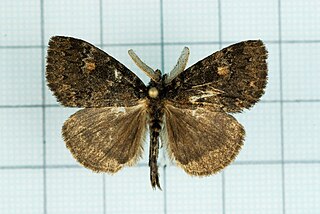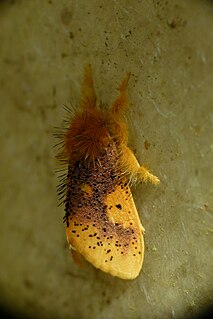
Ugia is a genus of moths in the family Erebidae erected by Francis Walker in 1858.
Labanda is a genus of moths of the family Nolidae erected by Francis Walker in 1859.

Egnasia is a genus of moths of the family Erebidae. The genus was first described by Francis Walker in 1859.

Hadennia is a genus of moths of the family Erebidae. The genus was described by Moore in 1885.

Ilema is a genus of tussock moths in the family Erebidae. The genus was described by Walker in 1855 and renamed by Moore in 1860, because Walker's chosen name was preoccupied.

Nygmia is a genus of tussock moths in the family Erebidae. The genus was erected by Jacob Hübner in 1820.

Amata cantori is a moth in the genus Amata of the subfamily Arctiinae. The species was first described by Frederic Moore in 1859. It is found on Peninsular Malaysia and Borneo.

Comostola is a genus of moths in the family Geometridae erected by Edward Meyrick in 1888. They are found primarily in Asia and Australia.

Ozola is a genus of moths in the family Geometridae first described by Francis Walker in 1861.

Zeheba is a genus of moths in the family Geometridae described by Moore in 1887.

Thyas honesta is a species of moth of the family Noctuidae first described by Jacob Hübner in 1824. It is found in the Indian subregion, Myanmar, Thailand, Peninsular Malaysia, Sumatra, Sri Lanka, Borneo and on the Philippines.

Agathia arcuata is a species of moth of the family Geometridae first described by Frederic Moore in 1868. It is found in India, Burma, Hainan, Peninsular Malaysia, Borneo, Sumatra and Java.

Tridrepana albonotata is a moth of the family Drepanidae described by Frederic Moore in 1879. It is found in India, Nepal, Vietnam, Sri Lanka, Peninsular Malaysia, Sumatra, Borneo, Java, Bali and Sulawesi.

Dysphania sagana is moth species in the family Geometridae first described by Druce in 1882. It is yellow and black and is found in southern Vietnam, Cambodia, Thailand, Peninsular Malaysia, Sumatra, and Borneo.

Cyana effracta is a moth of the family Erebidae first described by Francis Walker in 1854. It is found in Nepal, the north-eastern Himalayas, Taiwan, China, Burma, Peninsular Malaysia, Sumatra and Borneo.
Katha prabana is a moth of the family Erebidae first described by Frederic Moore in 1859. It is found on the Sula Islands, Borneo, Sumatra, Java, Bali, Sulawesi, the Moluccas and in Myanmar. The habitat consists of lowland areas.
Eugoa humerana is a moth of the family Erebidae first described by Francis Walker in 1863. It is found on Borneo, Peninsular Malaysia, Sumatra and Java. The habitat consists of forests.
Scaptesyle plumosus is a moth in the subfamily Arctiinae first described by Rothschild in 1912. It is found on Sumatra, Java, Peninsular Malaysia and Borneo. The habitat consists of coastal areas.
Vamuna maculata is a moth in the subfamily Arctiinae. It was described by Moore in 1878. It is found in India and on Peninsular Malaysia, Sumatra and Borneo.
Nygmia xanthomela is a moth of the family Erebidae first described by Francis Walker in 1862. It is found in Sri Lanka, Borneo, Java, Sumatra and Peninsular Malaysia.














